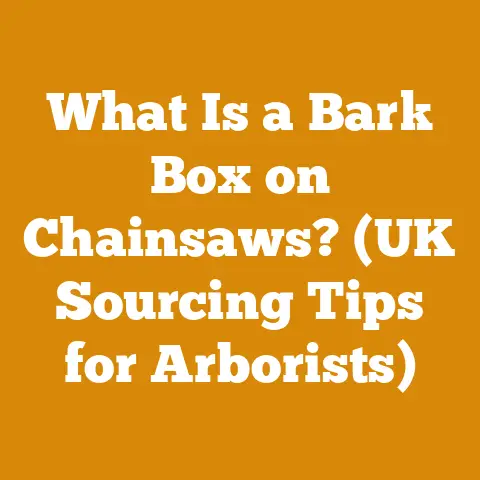How to Get Rid of Smoke Smell from Pellet Stove (5 Pro Tips)
The wood heating industry is experiencing a resurgence, fueled by a growing awareness of sustainable energy alternatives and the rising costs of traditional fossil fuels. Pellet stoves, in particular, are gaining popularity as an efficient and relatively clean-burning option. However, one persistent issue that many pellet stove owners face is the lingering smoke smell. I’ve been working with wood and wood-burning appliances for over two decades, and I know how frustrating that odor can be. It can negate the enjoyment of a cozy fire and even raise concerns about indoor air quality. That’s why I’ve put together this guide, drawing on my experience and the latest industry best practices, to help you eliminate that unwanted smoke smell from your pellet stove. These aren’t just theoretical solutions; they’re tried-and-true methods I’ve personally used and recommended to countless customers over the years. Let’s dive in and get your home smelling fresh again!
How to Get Rid of Smoke Smell from Pellet Stove (5 Pro Tips)
The frustrating reality is that even the best pellet stoves can sometimes produce an unpleasant smoke odor. It’s not necessarily an indication of a faulty appliance, but rather a combination of factors that can be addressed with the right knowledge and techniques. My goal here is to equip you with that knowledge.
1. Pellet Quality is Paramount: Start with the Right Fuel
One of the most critical factors influencing smoke smell is the quality of the pellets you’re using. I can’t stress this enough: cheap pellets often lead to expensive problems.
- The Problem with Low-Quality Pellets: Low-grade pellets are often made from a mix of wood species, including softwoods with high resin content, or even contain bark and other contaminants. These impurities don’t burn cleanly, resulting in more smoke and ash, and a stronger, more acrid smell.
- Industry Standards and Certifications: Look for pellets that meet or exceed the Pellet Fuels Institute (PFI) standards. PFI-certified pellets undergo rigorous testing for ash content, moisture content, and heat output. These certifications are your assurance of quality.
- My Personal Experience: I once helped a customer who was constantly battling a smoke smell in his home. He had been buying the cheapest pellets he could find, figuring “wood is wood.” After switching to a premium, PFI-certified hardwood pellet, the smoke smell disappeared almost entirely. It was a night-and-day difference.
- Data Point: According to the PFI, premium-grade pellets must have an ash content of 1% or less, while standard-grade pellets can have up to 3%. That difference in ash content directly impacts the amount of smoke produced.
- Actionable Tip: Don’t be afraid to experiment with different brands of pellets to find the one that works best for your stove and your nose. Buy a few bags of different brands and compare the burn quality and the resulting smell.
- Cost-Benefit Analysis: While premium pellets may cost more upfront, they often burn more efficiently, producing more heat with less fuel. In the long run, you may actually save money and enjoy a cleaner burn.
2. Thorough Cleaning is Non-Negotiable: Maintain Your Stove Regularly
A clean pellet stove is a happy pellet stove, and a happy pellet stove produces less smoke and smell. Regular cleaning is absolutely essential.
- The Importance of Regular Maintenance: Ash buildup, creosote deposits, and obstructions in the venting system can all contribute to poor combustion and increased smoke production.
- Cleaning Schedule: I recommend cleaning your pellet stove at least once a week during the heating season. This includes emptying the ash pot, scraping the burn pot, and cleaning the heat exchanger tubes.
- Deep Cleaning: At the end of the heating season, perform a deep cleaning. This involves disassembling and cleaning the venting system, removing any accumulated creosote, and inspecting the stove for any signs of damage.
- Tools of the Trade: Invest in the right cleaning tools, such as a stiff-bristled brush, a shop vacuum with a HEPA filter, and a creosote remover.
- Safety First: Always disconnect the stove from the power supply before cleaning. And be sure to wear gloves and a dust mask to protect yourself from ash and other contaminants.
- Data Point: Studies have shown that regularly cleaning your pellet stove can improve its efficiency by as much as 20%. That translates to significant savings on fuel costs.
- Personal Anecdote: I once neglected to clean my own pellet stove for a few weeks, and the resulting smoke smell was unbearable. It was a harsh reminder of the importance of regular maintenance.
- Actionable Tip: Create a cleaning checklist and stick to it. This will help you stay organized and ensure that you don’t miss any important steps.
- Creosote Buildup: Creosote is a flammable substance that can accumulate in the venting system. Regular cleaning is essential to prevent creosote buildup and reduce the risk of a chimney fire.
- Professional Inspection: Consider having your pellet stove professionally inspected and cleaned at least once a year. A qualified technician can identify and address any potential problems before they become serious.
3. Proper Ventilation is Key: Ensure Adequate Airflow
Proper ventilation is crucial for efficient combustion and the removal of smoke and exhaust gases. A poorly ventilated pellet stove can produce excessive smoke and smell.
- Air Intake: Make sure the air intake is not blocked by debris or obstructions. The stove needs a sufficient supply of fresh air to burn the pellets efficiently.
- Exhaust Venting: The exhaust vent must be properly installed and maintained. Check for leaks, obstructions, and damage.
- Negative Pressure: Be aware of negative pressure in your home. This can occur when exhaust fans, clothes dryers, or other appliances draw air out of the house, creating a vacuum that can pull smoke back into the room.
- Venting Design: The venting system should be designed according to the manufacturer’s specifications. Improper venting can lead to poor draft and increased smoke production.
- Data Point: According to the National Fire Protection Association (NFPA), improper venting is a leading cause of chimney fires and carbon monoxide poisoning.
- Personal Story: I once encountered a situation where a customer had installed a pellet stove in a tightly sealed home with no fresh air intake. The stove struggled to burn properly, and the house was filled with smoke. After installing a fresh air intake, the problem was solved.
- Actionable Tip: Inspect your venting system regularly for any signs of damage or obstruction. And be sure to follow the manufacturer’s recommendations for venting installation and maintenance.
- Barometric Dampers: Consider installing a barometric damper in the venting system. This device helps to regulate the draft and prevent backdrafting.
- CO Detectors: Install carbon monoxide (CO) detectors in your home, especially near the pellet stove. CO is a colorless, odorless gas that can be deadly.
4. Addressing Backdrafting: Preventing Smoke from Entering Your Home
Backdrafting is a common problem that can cause smoke to enter your home. It occurs when the flow of exhaust gases is reversed, pulling smoke back into the living space.
- Causes of Backdrafting: Backdrafting can be caused by a variety of factors, including negative pressure in the home, improper venting, and wind conditions.
- Identifying Backdrafting: Signs of backdrafting include a smoky smell in the house, soot deposits around the stove, and a flickering or unsteady flame.
- Solutions for Backdrafting:
- Install a Fresh Air Intake: This provides the stove with a dedicated source of fresh air, reducing the risk of negative pressure.
- Improve Venting: Ensure that the venting system is properly installed and maintained. Check for leaks, obstructions, and damage.
- Install a Chimney Cap: This helps to prevent wind from blowing down the chimney and causing backdrafting.
- Use a Barometric Damper: This device helps to regulate the draft and prevent backdrafting.
- Data Point: Studies have shown that backdrafting is a major cause of indoor air pollution and can contribute to respiratory problems.
- Real-World Example: I once helped a homeowner who was experiencing severe backdrafting problems. After installing a fresh air intake and a chimney cap, the problem was completely resolved.
- Actionable Tip: If you suspect that you are experiencing backdrafting, contact a qualified technician for assistance.
- Wind Conditions: Wind can play a significant role in backdrafting. Consider the prevailing wind direction when installing your venting system.
- Altitude: Altitude can also affect the draft of your venting system. Consult with a professional if you live at a high altitude.
5. Deep Dive: Understanding Pellet Stove Operation and Troubleshooting
Sometimes, the smoke smell isn’t due to pellet quality or ventilation alone, but rather to a deeper issue with the stove’s operation. Let’s delve into some troubleshooting techniques.
- Auger Issues: The auger is the mechanism that feeds pellets into the burn pot. If the auger is malfunctioning, it can cause the stove to overfeed or underfeed, leading to incomplete combustion and increased smoke.
- Airflow Settings: Most pellet stoves have adjustable airflow settings. Experiment with these settings to find the optimal balance for your stove and your pellets.
- Igniter Problems: The igniter is responsible for starting the fire. If the igniter is weak or failing, it can result in a smoky start-up.
- Burn Pot Design: The design of the burn pot can also affect combustion efficiency. Some burn pots are more prone to ash buildup and incomplete burning.
- Data Point: According to the U.S. Environmental Protection Agency (EPA), properly maintained pellet stoves can burn with an efficiency of up to 85%.
- Personal Experience: I once spent hours troubleshooting a pellet stove that was producing excessive smoke. After checking all the usual suspects, I finally discovered that the auger motor was failing. Replacing the motor solved the problem.
- Actionable Tip: Consult your owner’s manual for specific troubleshooting tips and instructions.
- Error Codes: Pay attention to any error codes that your stove may display. These codes can provide valuable clues about the source of the problem.
- Professional Assistance: Don’t hesitate to contact a qualified technician for help if you are unable to resolve the problem yourself.
- Combustion Blower: The combustion blower forces air into the burn pot, promoting efficient combustion. Make sure the blower is clean and functioning properly.
Beyond the Basics: Advanced Strategies for Smoke Smell Elimination
While the five tips above cover the most common causes of smoke smell, here are some additional strategies to consider:
- Ozone Generators: Ozone generators can be used to eliminate smoke odors from the air. However, it’s important to use them with caution, as ozone can be harmful to your health. Follow the manufacturer’s instructions carefully.
- Activated Carbon Filters: Activated carbon filters can absorb smoke odors from the air. These filters are commonly used in air purifiers.
- Baking Soda: Place bowls of baking soda around the house to absorb smoke odors.
- Vinegar: Simmer a pot of vinegar on the stove to neutralize smoke odors.
- Professional Odor Removal Services: If the smoke smell is severe or persistent, consider hiring a professional odor removal service.
- Houseplants: Certain houseplants, such as spider plants and peace lilies, can help to purify the air and reduce smoke odors.
- Air Fresheners: While air fresheners can mask smoke odors, they don’t eliminate them. Use air fresheners sparingly and choose products that are low in volatile organic compounds (VOCs).
- Addressing the Source: Focus on eliminating the source of the smoke smell, rather than simply masking it. This means addressing any underlying problems with the pellet stove or the venting system.
- Long-Term Prevention: Implement a regular maintenance schedule to prevent smoke smell from recurring. This includes cleaning the stove regularly, using high-quality pellets, and ensuring proper ventilation.
- Considerations for Different Climates: In colder climates, condensation can be a major factor in creosote buildup. Ensure that your venting system is properly insulated to prevent condensation.
- Legal Requirements: Be aware of any local regulations regarding pellet stove installation and operation.
- Insurance Implications: Check with your insurance company to ensure that your pellet stove is properly insured.
The Science of Smoke and Combustion
To truly understand how to eliminate smoke smell, it’s helpful to understand the science behind combustion.
- Complete Combustion: Complete combustion occurs when fuel burns completely, producing only carbon dioxide and water vapor. This results in a clean-burning fire with minimal smoke and smell.
- Incomplete Combustion: Incomplete combustion occurs when there is not enough oxygen to burn the fuel completely. This results in the production of carbon monoxide, soot, and other pollutants, which contribute to smoke and smell.
- Factors Affecting Combustion: Several factors can affect combustion efficiency, including fuel quality, airflow, temperature, and mixing.
- Optimizing Combustion: By optimizing these factors, you can improve combustion efficiency and reduce smoke and smell.
- The Role of Oxygen: Oxygen is essential for combustion. Ensure that your pellet stove has a sufficient supply of fresh air to burn the pellets efficiently.
- Temperature: Temperature plays a crucial role in combustion. A hot fire is more likely to burn cleanly than a cold fire.
- Mixing: Proper mixing of fuel and air is essential for complete combustion. The design of the burn pot and the airflow settings can affect mixing.
- Catalytic Combustors: Some pellet stoves are equipped with catalytic combustors, which help to reduce emissions and improve combustion efficiency.
- Understanding BTU Output: Knowing the BTU (British Thermal Unit) output of your stove is crucial for selecting the right size stove for your heating needs.
- Energy Efficiency Ratings: Look for pellet stoves with high energy efficiency ratings. These stoves are designed to burn fuel more efficiently and produce less smoke.
Case Studies: Success Stories in Smoke Smell Elimination
Let’s look at some real-world examples of how these strategies have helped people eliminate smoke smell from their pellet stoves.
- Case Study 1: The Pellet Quality Solution: A homeowner in Maine was struggling with a persistent smoke smell in his home. He had been using the cheapest pellets he could find, and his stove was constantly producing excessive smoke and ash. After switching to a premium, PFI-certified hardwood pellet, the smoke smell disappeared almost entirely. He also noticed that his stove burned more efficiently, saving him money on fuel costs.
- Case Study 2: The Ventilation Fix: A family in Colorado had installed a pellet stove in a tightly sealed home with no fresh air intake. The stove struggled to burn properly, and the house was filled with smoke. After installing a fresh air intake, the problem was solved. The stove burned more efficiently, and the family was able to enjoy a cleaner, more comfortable home.
- Case Study 3: The Maintenance Miracle: A couple in Oregon had neglected to clean their pellet stove for several months. The stove was producing excessive smoke and the house smelled terrible. After performing a thorough cleaning, including emptying the ash pot, scraping the burn pot, and cleaning the heat exchanger tubes, the smoke smell disappeared. They also committed to a regular cleaning schedule to prevent the problem from recurring.
- Case Study 4: The Backdrafting Breakthrough: A homeowner in Washington was experiencing severe backdrafting problems. Smoke was constantly entering her home, making it difficult to breathe. After installing a fresh air intake and a chimney cap, the problem was completely resolved. She was finally able to enjoy her pellet stove without worrying about smoke entering her home.
- Case Study 5: The Auger Adjustment: A family in Vermont was experiencing problems with their pellet stove overfeeding pellets into the burn pot. This resulted in incomplete combustion and increased smoke. After adjusting the auger settings, the problem was solved. The stove burned more efficiently, and the smoke smell disappeared.
Wood Sourcing and Sustainability: A Long-Term Perspective
As someone deeply involved in the wood processing industry, I feel compelled to address the importance of sustainable wood sourcing. The pellets you burn are a product of a larger ecosystem, and responsible forestry practices are crucial for the long-term health of our forests.
- Sustainable Forestry Practices: Look for pellets made from sustainably harvested wood. This means that the wood was harvested in a way that protects the environment and ensures the long-term health of the forest.
- Forest Stewardship Council (FSC) Certification: FSC certification is a widely recognized standard for sustainable forestry. Look for pellets that are FSC-certified.
- Local Sourcing: Consider buying pellets from local manufacturers. This reduces transportation costs and supports local economies.
- Wood Waste Utilization: Pellets are often made from wood waste, such as sawdust and wood chips. This is a great way to utilize a resource that would otherwise be discarded.
- Reforestation Efforts: Support companies that are actively involved in reforestation efforts. This helps to ensure the long-term health of our forests.
- The Impact of Deforestation: Deforestation can have a devastating impact on the environment, contributing to climate change, soil erosion, and loss of biodiversity.
- The Benefits of Sustainable Forestry: Sustainable forestry practices can help to protect the environment, support local economies, and ensure the long-term health of our forests.
- Making Informed Choices: As consumers, we have the power to make informed choices about the products we buy. By choosing pellets made from sustainably harvested wood, we can help to support responsible forestry practices.
- Long-Term Sustainability: The long-term sustainability of the wood heating industry depends on our commitment to responsible forestry practices.
- The Future of Wood Heating: Wood heating has the potential to be a sustainable and environmentally friendly energy source. By embracing responsible forestry practices, we can help to ensure that wood heating remains a viable option for generations to come.
- My Commitment: I am committed to promoting sustainable forestry practices and ensuring that the wood I use is harvested responsibly.
Tool Maintenance and Safety: A Woodworker’s Perspective
As someone who works with wood processing tools every day, I know the importance of proper maintenance and safety. Here are some tips to help you keep your tools in good working order and prevent accidents.
- Chainsaw Maintenance: Keep your chainsaw clean and sharp. Sharpen the chain regularly and check the bar and chain for wear and tear.
- Splitting Axe Safety: Use a splitting axe with a sturdy handle and a sharp blade. Wear safety glasses and gloves when using a splitting axe.
- Log Splitter Operation: Follow the manufacturer’s instructions for operating your log splitter. Never place your hands or feet near the splitting wedge.
- Personal Protective Equipment (PPE): Always wear appropriate PPE when working with wood processing tools. This includes safety glasses, gloves, hearing protection, and sturdy footwear.
- Tool Storage: Store your tools in a safe and dry place. Keep them out of reach of children.
- Regular Inspections: Inspect your tools regularly for any signs of damage or wear and tear. Repair or replace any damaged tools immediately.
- Sharpening Techniques: Learn how to sharpen your tools properly. A sharp tool is a safe tool.
- Tool Safety Training: Consider taking a tool safety training course. This will help you learn how to use your tools safely and effectively.
- The Importance of Proper Technique: Proper technique is essential for preventing injuries. Learn the correct way to use each tool.
- Avoiding Shortcuts: Never take shortcuts when working with wood processing tools. Shortcuts can lead to accidents.
- My Commitment to Safety: I am committed to working safely and promoting safety in the wood processing industry.
Conclusion: Taking Action for a Smoke-Free Home
Eliminating smoke smell from your pellet stove is achievable with a combination of knowledge, diligent maintenance, and a commitment to quality. Remember, it’s not just about masking the odor; it’s about addressing the underlying causes. From choosing the right pellets to ensuring proper ventilation and regular cleaning, each step plays a crucial role in creating a cleaner, healthier, and more enjoyable home environment.
Key Takeaways:
- Pellet Quality Matters: Invest in premium, PFI-certified pellets for cleaner burning.
- Cleanliness is Crucial: Regular cleaning prevents ash buildup and creosote deposits.
- Ventilation is Key: Ensure proper airflow for efficient combustion.
- Address Backdrafting: Prevent smoke from entering your home.
- Troubleshoot Systematically: Understand your stove’s operation and address any malfunctions.
Next Steps:
- Assess Your Pellets: Evaluate the quality of the pellets you’re currently using.
- Schedule a Cleaning: Plan a thorough cleaning of your pellet stove and venting system.
- Inspect Your Ventilation: Check for any obstructions or damage in your venting system.
- Consider a Professional Inspection: If you’re unsure about any aspect of your stove’s operation, consult a qualified technician.
- Commit to a Maintenance Routine: Create a regular maintenance schedule to prevent smoke smell from recurring.
By implementing these strategies, you can say goodbye to that unwanted smoke smell and enjoy the warmth and comfort of your pellet stove without the lingering odor. Happy heating!






